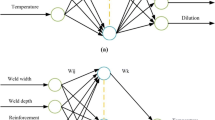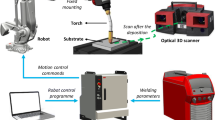Abstract
Cold metal transfer (CMT)–based wire-arc additive manufacturing (WAAM) is increasingly popular for the production of large and complex metallic components due to its high deposition rate, low heat input, and excellent material efficiency. The accurate prediction of the bead geometry is of great importance to enhance the stability of the process and its dimensional accuracy. Besides the wire feed speed (WFS) and travel speed (TS), the interlayer temperature is another key factor in determining the bead geometry because of the heat accumulation in the multilayer deposition. In this paper, considering the varying interlayer temperature, WFS, and TS as inputs, an artificial neural network (ANN) is developed to predict the bead width, height, and contact angle; then, by connecting the ANN model with a bead geometric model, a combined model is established to improve the ANN model. Based on experimental test data, with random combinations of input parameters, the combined model is demonstrated to be able to accurately predict the bead geometry (mean error < 5.1%). The general effect of interlayer temperature on the bead geometry was also investigated by experiment.












Similar content being viewed by others
Data availability
All data generated or analyzed during this study are included in this manuscript.
Code availability
Not applicable.
References
Ding D, Pan Z, Cuiuri D, Li H (2015) Wire-feed additive manufacturing of metal components: technologies, developments and future interests. Int J Adv Manuf Technol 81:465–481. https://doi.org/10.1007/s00170-015-7077-3
Le VT, Paris H (2021) On the use of gas-metal-arc-welding additive manufacturing for repurposing of low-carbon steel components: microstructures and mechanical properties. Weld World. https://doi.org/10.1007/s40194-020-01005-y
Frostevarg J, Kaplan AFH, Lamas J (2014) Comparison of CMT with other arc modes for laser-arc hybrid welding of steel. Weld World. https://doi.org/10.1007/s40194-014-0146-7
Cong B, Ding J, Williams S (2015) Effect of arc mode in cold metal transfer process on porosity of additively manufactured Al-6.3%Cu alloy. Int J Adv Manuf Technol 76:1593–1606. https://doi.org/10.1007/s00170-014-6346-x
Ali Y, Henckell P, Hildebrand J et al (2019) Wire arc additive manufacturing of hot work tool steel with CMT process. J Mater Process Technol 269:109–116. https://doi.org/10.1016/j.jmatprotec.2019.01.034
Youheng F, Guilan W, Haiou Z et al (2017) Optimization of surface appearance for wire and arc additive manufacturing of Bainite steel. Int J Adv Manuf Technol 91:301–313. https://doi.org/10.1007/s00170-016-9621-1
Ayarkwa KF, Williams S, Ding J (2015) Investigation of pulse advance cold metal transfer on aluminium wire arc additive manufacturing. Int J Rapid Manuf 5:44. https://doi.org/10.1504/ijrapidm.2015.073547
Kazanas P, Deherkar P, Almeida P et al (2012) Fabrication of geometrical features using wire and arc additive manufacture. Proc Inst Mech Eng Part B J Eng Manuf. https://doi.org/10.1177/0954405412437126
Zhao W, Wei Y, Long J et al (2021) Modeling and simulation of heat transfer, fluid flow and geometry morphology in GMAW-based wire arc additive manufacturing. Weld World. https://doi.org/10.1007/s40194-021-01123-1
Vázquez L, Rodríguez N, Rodríguez I et al (2020) Influence of interpass cooling conditions on microstructure and tensile properties of Ti-6Al-4V parts manufactured by WAAM. Weld World. https://doi.org/10.1007/s40194-020-00921-3
Reisgen U, Sharma R, Mann S, Oster L (2020) Increasing the manufacturing efficiency of WAAM by advanced cooling strategies. Weld World. https://doi.org/10.1007/s40194-020-00930-2
Ma Y, Cuiuri D, Shen C et al (2015) Effect of interpass temperature on in-situ alloying and additive manufacturing of titanium aluminides using gas tungsten arc welding. Addit Manuf 8:71–77. https://doi.org/10.1016/j.addma.2015.08.001
Shen C, Pan Z, Cuiuri D et al (2017) Influences of deposition current and interpass temperature to the Fe3Al-based iron aluminide fabricated using wire-arc additive manufacturing process. Int J Adv Manuf Technol 88:2009–2018. https://doi.org/10.1007/s00170-016-8935-3
Wu B, Ding D, Pan Z et al (2017) Effects of heat accumulation on the arc characteristics and metal transfer behavior in Wire Arc Additive Manufacturing of Ti6Al4V. J Mater Process Technol 250:304–312. https://doi.org/10.1016/j.jmatprotec.2017.07.037
Xiong J, Li Y, Li R, Yin Z (2018) Influences of process parameters on surface roughness of multi-layer single-pass thin-walled parts in GMAW-based additive manufacturing. J Mater Process Technol 252:128–136. https://doi.org/10.1016/j.jmatprotec.2017.09.020
Yang D, Wang G, Zhang G (2017) Thermal analysis for single-pass multi-layer GMAW based additive manufacturing using infrared thermography. J Mater Process Technol 244:215–224. https://doi.org/10.1016/j.jmatprotec.2017.01.024
Xiong J, Zhang G, Hu J, Li Y (2013) Forecasting process parameters for GMAW-based rapid manufacturing using closed-loop iteration based on neural network. Int J Adv Manuf Technol 69:743–751. https://doi.org/10.1007/s00170-013-5038-2
Xiong J, Zhang G, Hu J, Wu L (2014) Bead geometry prediction for robotic GMAW-based rapid manufacturing through a neural network and a second-order regression analysis. J Intell Manuf 25:157–163. https://doi.org/10.1007/s10845-012-0682-1
Ríos S, Colegrove PA, Martina F, Williams SW (2018) Analytical process model for wire + arc additive manufacturing. Addit Manuf 21:651–657. https://doi.org/10.1016/j.addma.2018.04.003
Nagesh DS, Datta GL (2002) Prediction of weld bead geometry and penetration in shielded metal-arc welding using artificial neural networks. J Mater Process Technol 123:303–312. https://doi.org/10.1016/S0924-0136(02)00101-2
Rao PS, Gupta OP, Murty SSN, Rao ABK (2009) Effect of process parameters and mathematical model for the prediction of bead geometry in pulsed GMA welding. Int J Adv Manuf Technol. https://doi.org/10.1007/s00170-009-1991-1
Bourlet C, Zimmer-Chevret S, Pesci R et al (2020) Microstructure and mechanical properties of high strength steel deposits obtained by Wire-Arc Additive Manufacturing. J Mater Process Technol. https://doi.org/10.1016/j.jmatprotec.2020.116759
Spencer JD, Dickens PM, Wykes CM (1998) Rapid prototyping of metal parts by three-dimensional welding. Proc Inst Mech Eng Part B J Eng Manuf 212:175–182. https://doi.org/10.1243/0954405981515590
Hu S, Zhang H, Wang Z et al (2016) The arc characteristics of cold metal transfer welding with AZ31 magnesium alloy wire. J Manuf Process. https://doi.org/10.1016/j.jmapro.2016.10.001
Ola OT, Doern FE (2014) A study of cold metal transfer clads in nickel-base INCONEL 718 superalloy. Mater Des. https://doi.org/10.1016/j.matdes.2013.12.060
Selvi S, Vishvaksenan A, Rajasekar E (2018) Cold metal transfer (CMT) technology - An overview. Def Technol 14:28–44. https://doi.org/10.1016/j.dt.2017.08.002
Manikya Kanti K, Srinivasa Rao P (2008) Prediction of bead geometry in pulsed GMA welding using back propagation neural network. J Mater Process Technol. https://doi.org/10.1016/j.jmatprotec.2007.09.034
Acknowledgements
The authors would like to thank the CPER (State-Region contract) Cyber-Enterprises and the Grand Est region funding plans, as well as the technical staff at ENSAM-Arts et Métiers, in particular M. Sylvio De Paolis and M. Daniel Boehm, for their support and investment during the experimental campaign.
Author information
Authors and Affiliations
Corresponding author
Ethics declarations
Conflict of interest
The authors declare no competing interests.
Additional information
Publisher's note
Springer Nature remains neutral with regard to jurisdictional claims in published maps and institutional affiliations.
Recommended for publication by Commission I - Additive Manufacturing, Surfacing, and Thermal Cutting
Rights and permissions
About this article
Cite this article
Wang, Z., Zimmer-Chevret, S., Léonard, F. et al. Prediction of bead geometry with consideration of interlayer temperature effect for CMT-based wire-arc additive manufacturing. Weld World 65, 2255–2266 (2021). https://doi.org/10.1007/s40194-021-01192-2
Received:
Accepted:
Published:
Issue Date:
DOI: https://doi.org/10.1007/s40194-021-01192-2




